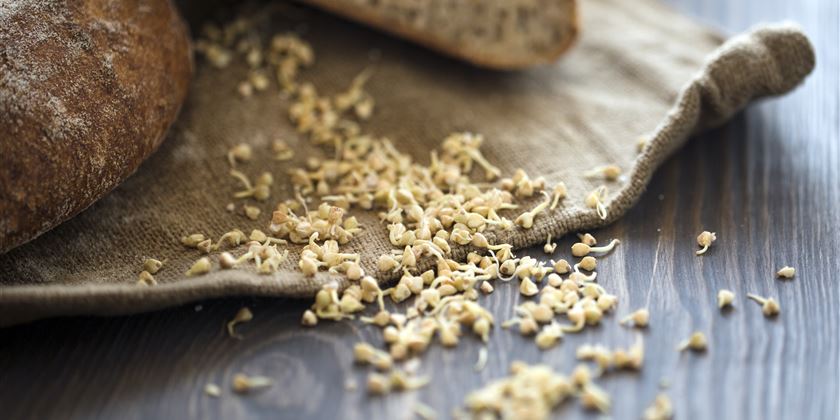Gluten-free and low-FODMAP sourdoughs for patients with celiac disease and irritable bowel syndrome (IBS): A clinical perspective

Muir J, Varney J, Ajamian M, Gibson P. International Journal of Food Microbiology. 2018; 290 (2019): 237-246
Gluten is often vilified as a trigger for a variety of gastrointestinal (GI) symptoms, which has increased the demand for gluten-free products worldwide. In the United States, approximately 20% of consumers report that they avoid gluten, despite the fact that only 1% of the population is afflicted with celiac disease.
Gluten is often vilified as a trigger for a variety of gastrointestinal (GI) symptoms, which has increased the demand for gluten-free products worldwide. In the United States, approximately 20% of consumers report that they avoid gluten, despite the fact that only 1% of the population is afflicted with celiac disease.
Muir et al. suspect that this trend of gluten avoidance may be driven by the incorrect perception that gluten-free diets are healthier than typical diets. However, there are many individuals without celiac disease who report improvement in GI symptoms by following a gluten-free diet. This is referred to as non-celiac gluten sensitivity (NCGS). These individuals typically report symptoms of bloating, abdominal pain, altered bowel movements, and a variety of extra-intestinal symptoms that are associated with consumption of gluten-containing foods.
Researchers at Monash University have identified specific short chain carbohydrates, called FODMAPs, which are poorly absorbed and rapidly fermented in the large intestine. FODMAPs are suspected to trigger GI symptoms in many individuals (10-15% of the U.S. population). Two of these FODMAPs, fructrans and galacto-oligosaccharides (GOS), are widely prevalent in gluten-containing foods. Thus, the authors propose that FODMAPs, not gluten, induce symptoms in those with NCGS.
The low-FODMAPs diet is a typical diet therapy for individuals with IBS. There are three phases to the diet (see below). In order to ensure that nutritional needs are being met, this diet should only be initiated under the guidance of a dietitian.
Though the low-FODMAPs diet is not a gluten-free diet, gluten-free foods tend to be lower in FODMAPs. This may explain why so many people with IBS and NCGS report improvement in symptoms while following a gluten-free diet.
The Role of Sourdough
The authors identify sourdough processing as a means for lowering the FODMAP content of bread. In this case, the yeasts in sourdough culture appear to degrade FODMAPs, particularly fructans and GOS, in wheat-based foods. Many patients with IBS and NCGS report improved tolerance with sourdough style breads. This is an important consideration for those suffering from IBS and NCGS, as unnecessarily restrictive diets may eventually lead to nutrient deficiencies and reduced quality of life. Utilization of sourdough starters may be an opportunity for food manufacturers to create breads that are more well-tolerated by this large group.
Lifelong adherence to a gluten-free diet is medically necessary for celiac disease patients. However, this diet can be very restrictive and difficult to follow. This research suggests that a more liberalized diet may be possible for patients with IBS and NCGS. A greater understanding of the specific food components that trigger adverse GI symptoms is necessary in order to improve diet quality and overall food tolerance among individuals with IBS and NCGS.
https://www.ncbi.nlm.nih.gov/pubmed/?term=gluten-free+and+low-fodmap+sourdoughs
Researchers at Monash University have identified specific short chain carbohydrates, called FODMAPs, which are poorly absorbed and rapidly fermented in the large intestine. FODMAPs are suspected to trigger GI symptoms in many individuals (10-15% of the U.S. population). Two of these FODMAPs, fructrans and galacto-oligosaccharides (GOS), are widely prevalent in gluten-containing foods. Thus, the authors propose that FODMAPs, not gluten, induce symptoms in those with NCGS.
The low-FODMAPs diet is a typical diet therapy for individuals with IBS. There are three phases to the diet (see below). In order to ensure that nutritional needs are being met, this diet should only be initiated under the guidance of a dietitian.
- Phase 1: FODMAPs are restricted for 2-6 weeks.
- Phase 2: Food challenges are initiated to identify which FODMAPs are causing the patient’s GI symptoms.
- Phase 4: Well-tolerated FODMAPs are reincorporated into the diet, while poorly tolerated FODMAPs continue to be restricted.
Though the low-FODMAPs diet is not a gluten-free diet, gluten-free foods tend to be lower in FODMAPs. This may explain why so many people with IBS and NCGS report improvement in symptoms while following a gluten-free diet.
The Role of Sourdough
The authors identify sourdough processing as a means for lowering the FODMAP content of bread. In this case, the yeasts in sourdough culture appear to degrade FODMAPs, particularly fructans and GOS, in wheat-based foods. Many patients with IBS and NCGS report improved tolerance with sourdough style breads. This is an important consideration for those suffering from IBS and NCGS, as unnecessarily restrictive diets may eventually lead to nutrient deficiencies and reduced quality of life. Utilization of sourdough starters may be an opportunity for food manufacturers to create breads that are more well-tolerated by this large group.
Lifelong adherence to a gluten-free diet is medically necessary for celiac disease patients. However, this diet can be very restrictive and difficult to follow. This research suggests that a more liberalized diet may be possible for patients with IBS and NCGS. A greater understanding of the specific food components that trigger adverse GI symptoms is necessary in order to improve diet quality and overall food tolerance among individuals with IBS and NCGS.
https://www.ncbi.nlm.nih.gov/pubmed/?term=gluten-free+and+low-fodmap+sourdoughs
www.drschaer-institute.com
